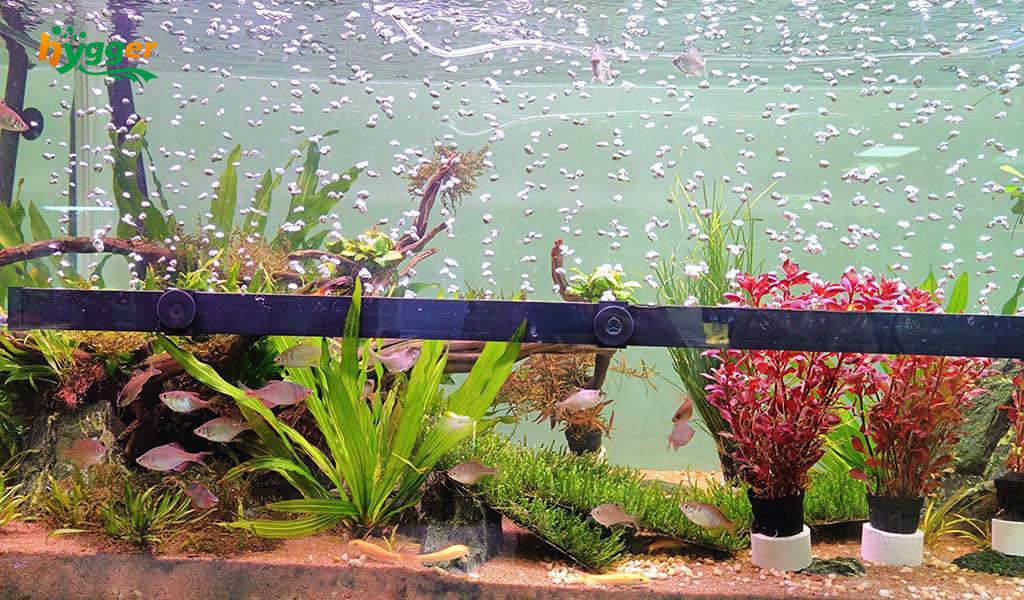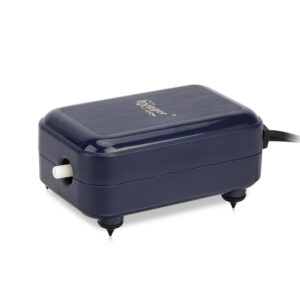A bubble curtain can be a captivating element in your aquarium. While it enhances the aesthetic appeal, it also provides functional benefits, like water circulation and increasing oxygen levels. Creating a bubble curtain is a relatively straightforward process. In this guide, we will share how to make bubble curtains for aquariums.
Content Table
Air Bubble Curtains for Aquariums
What is an air bubble curtain in aquariums?
Air bubble curtains are created by air stones or diffusers, which are generally placed along the bottom or sides of aquariums. They will release air bubbles in aquariums. The bubbles will rise to the water’s surface, creating an appealing visual effect.
Overall, air bubble curtains can be a captivating addition to fish tanks. While the bubble curtains improve the ornamental value of aquariums, they also contribute to providing a soothing and healthy living environment.
Aquariums need an air bubble curtain
Considering the requirements of aquatic pets, creating an air bubble curtain is essential for some aquarium types. Here are some examples.
- Saltwater reef aquariums
Reef aquariums, especially those with corals and invertebrates, can benefit from air bubble curtains. The rising bubbles provide additional water movement and surface agitation, which helps facilitate gas exchange, maintain oxygen levels, and prevent the formation of stagnant areas.
- High-density fish tanks
Aquariums that house many fish in a limited space might require additional oxygenation. Air bubble curtains can help increase oxygen levels in such tanks. This is particularly relevant in breeding tanks, where maintaining optimal oxygenation is crucial.
- Aquaponics systems
Aquaponics combines fish farming with hydroponics, creating a symbiotic relationship between fish and plants. In these systems, air bubble curtains can serve the dual purpose of oxygenating the water for the fish and providing added aeration for the plant roots submerged in the water.

Aquariums do not need an air bubble curtain
The air bubble curtains are not necessary for aquariums with sufficient oxygen levels or inhabitants incompatible with increased water flow. For example, some fish species, such as those that prefer calmer water or have delicate fins, may be stressed facing increasing water movement caused by bubbles.
Given below are some types of aquariums that do not need the air bubble curtains.
- Freshwater planted aquariums
Planted aquariums with a healthy and well-maintained aquatic plant population can provide excellent oxygenation through photosynthesis. The plants release oxygen into the water during the day, contributing to the overall oxygen levels without the need for additional air bubbles.
- Low-tech or natural aquariums
Low-tech aquarium setups, which typically feature low lighting, minimal equipment, and a balanced ecosystem, can maintain sufficient oxygen levels through natural processes. These aquariums often rely on the exchange of gases at the water surface, surface agitation from gentle filtration, or slow water movement to ensure oxygenation.
- Fish-only aquariums
In aquariums that solely house fish without live plants, sufficient oxygenation can often be achieved through the use of efficient filtration systems. Filters with appropriate water turnover rates and surface agitation can provide enough oxygen exchange to meet the needs of the fish.
What Do Bubble Curtains Do in an Aquarium?
Air bubble curtains in an aquarium serve decorative and functional purposes. In this segment, we will cover the purposes of air bubble curtains in an aquarium.
Aesthetic appeal
One of the primary purposes of air bubble curtains is to enhance the visual appeal and improve the aesthetic values of aquariums. The cascading stream of rising bubbles creates a dynamic and mesmerizing effect, adding movement to the tank.

Oxygenation aquarium water
Air bubble curtains help in oxygenating the aquarium water. As the bubbles rise to the water’s surface, the gas exchange gets promoted, allowing oxygen from the air to dissolve into the water. This is particularly important for the well-being of fish and other aquatic organisms that require sufficient oxygen for respiration.
Water circulation
The rising bubbles created by air bubble curtains contribute to water circulation in the aquarium. They help break up stagnant areas, promote even distribution of heat, nutrients, and oxygen, and prevent the formation of dead zones in the water.
Surface agitation
The bubbles breaking at the surface of the water create surface agitation. This agitation aids in oxygen exchange and helps to prevent the formation of a thin film or scum on the water surface. It also improves water movement, which can be beneficial for maintaining water quality and preventing the accumulation of debris.
How Does a Bubble Curtain Work
An air bubble curtain works by utilizing an air pump, airline tubing, and an air stone or diffuser to release a stream of rising bubbles. Generally, when the air pump is turned on, it forces air through the airline tubing and into the air stone or diffuser. The air stone or diffuser then releases the air in the form of small bubbles into the water. The released bubbles rise to the surface of the water due to their buoyancy. As they ascend, they create a visually striking curtain-like effect, with a continuous stream of bubbles moving upwards.
Also, the air bubble curtains can be adjusted based on tank needs, such as the size and number of bubbles released, overall flow rate, and the position of the air stone or diffuser.
Next, we will list some necessary materials to create air bubble curtains.
- Airline tubing: It serves as a conduit for the airflow from the air pump to the air stone or diffuser. It transfers the pressurized air from the pump to the desired location in the aquarium.
- Air pump: It is a device that generates air pressure. An air pump can be connected to the air bubble curtain setup using airline tubing.
- Air stone or diffuser: The airline tubing is connected to an air stone or diffuser, which is placed within the aquarium. The air stone or diffuser is often positioned along the bottom or sides of the tank, depending on the desired effect.
How to Make Bubble Curtains in Fish Tanks
Create air bubble curtains with aquarium aeration supplies
1) Preparing to make air bubble curtains
Before making bubble curtains for fish tanks, you should prepare some necessary materials in advance, including:
- Air pump: Select an appropriate air pump based on aquarium size.
- Airline tubing: Get enough airline tubing to reach from the air pump to the desired location in your tank.
- Air stone or diffuser: Choose an air stone or diffuser that suits your preferences. Air stones are porous and create multiple small bubbles, while diffusers release larger bubbles.

2) Steps to make air bubble curtains
- Step 1: Position your air pump
Place the air pump near your fish tank. And make sure the pump is stable and above the water level. You can secure it to a wall or cabinet with the help of suction cups or hooks.
- Step 2: Connect airline tubing
Attach one end of the airline tubing to the air pump’s outlet nozzle. Push the tubing firmly onto the nozzle to create a secure connection.
- Step 3: Position your air stone or diffuser
Decide where you want to place the air stone or diffuser in your tank. You can place it along the back wall, behind decorations, or on the substrate. But you should ensure it is submerged and secured in the desired location.
- Step 4: Adjust the airline tubing
Measure the distance from the air pump to the air stone or diffuser and cut the airline tubing to the appropriate length. Do not forget to leave some extra length to accommodate any curves or bends. After that, attach the other end of the airline tubing to the air stone or diffuser. Secure it tightly to prevent air leakage.
- Step 5: Test your air bubble curtain
Plug in the air pump and observe the flow of bubbles from the air stone or diffuser. Adjust the airflow rate of the air pump, if necessary, using any control valves or adjustments provided.
Create air bubble curtains without aquarium aeration supplies
Facing a shortage of aquarium aeration supplies, why not try to make bubble curtains using household items?
1) Essential materials
- Plastic drinking straws
- Rubber band or string
- Airline tubing (if available)
- Air pump (optional, if you have one)
2) Simple approaches to making a bubble curtain
Firstly, gather several plastic drinking straws and cut them into equal lengths, around 4–6 inches each. The number of straws depends on the desired length and density of the bubble curtain.
Next, bundle the straws together and secure them tightly using a rubber band or string. Ensure they are aligned in a straight line, creating a curtain-like shape. If you have airline tubing available, connect one end to the bundled straws using a secure knot or tape. This will allow you to attach the tubing to an air pump if you have one. If not, proceed to the next step.
After that, submerge the bundled straws in your aquarium. Ensure the straws are fully submerged but still accessible for adjustments if needed. Then, blow air into the open ends of the straws to create bubbles. You can either blow directly into each straw or use a separate tube to blow air into the straws.
Final Thoughts
In a nutshell, you can create air bubble curtains with aquarium aeration supplies or household items (e.g. plastic drinking straws). Nonetheless, too many bubbles are not good for your tank. Whether your aquarium needs an air bubble curtain or not depends on fish species, plants, other aquatic pets, the status of the filtration system, and overall aquarium conditions.


Leave a comment